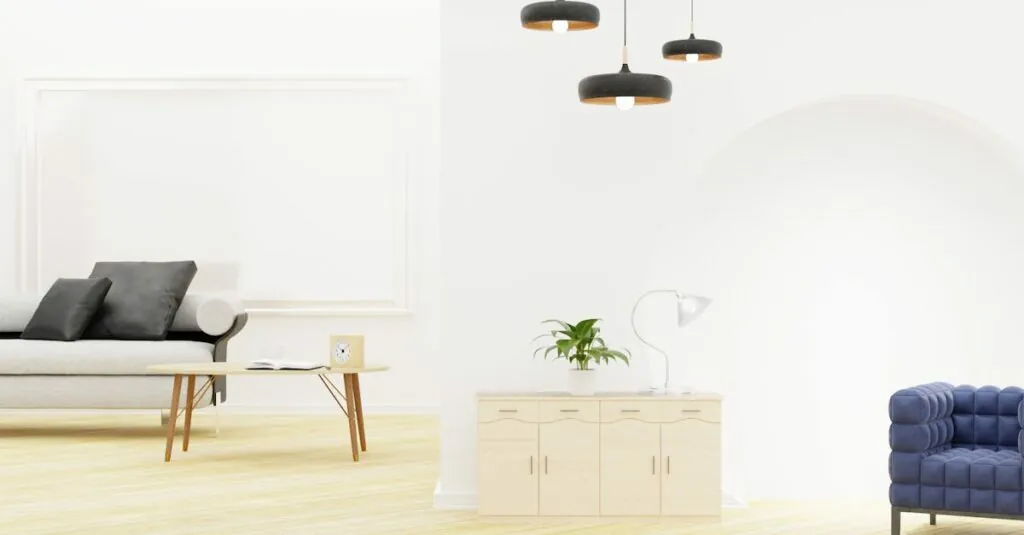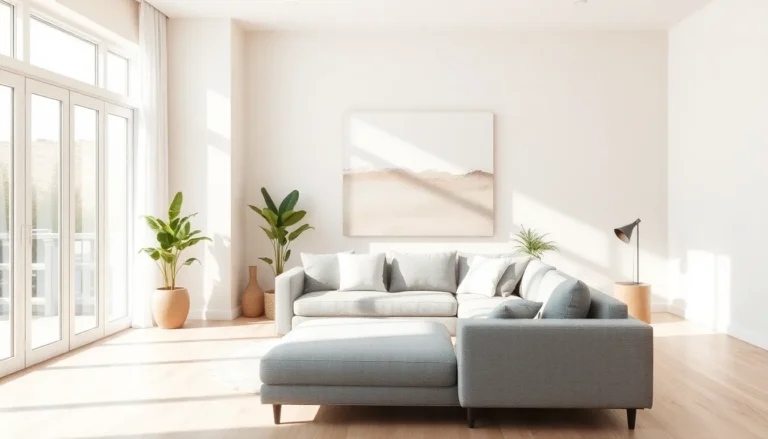Table of Contents
ToggleIn a world overflowing with clutter and chaos, minimalist living rooms offer a refreshing escape. Imagine a space where less truly is more, allowing you to breathe easy and enjoy every square inch without the visual noise. It’s not just a trend; it’s a lifestyle choice that transforms your home into a serene sanctuary.
Benefits Of Minimalist Living Room Decor
Minimalist living room decor offers various advantages that enhance both aesthetics and functionality. Clarity emerges when spaces are free from excessive items, creating a tranquil atmosphere that fosters relaxation. Simplicity promotes easy maintenance, as fewer objects mean less dust and clutter to manage.
Functionality increases in a well-organized minimalist room. Essential furniture and decor items serve dual purposes, ensuring efficient use of space. For instance, a coffee table with storage capabilities keeps essential items accessible yet out of sight.
Mental clarity often follows a minimalist approach. Freed from distractions, individuals can focus better on tasks, creativity, or social interactions. The calming color palettes common in minimalist designs further contribute to a serene mood, enhancing overall well-being.
Budget considerations play a role, too. Investing in fewer, high-quality pieces can reduce overall expenditure on decor. Individuals can prioritize functionality over quantity, acquiring items that are both stylish and practical.
A minimalist living room also supports sustainability. Choosing environmentally friendly materials fosters a commitment to eco-conscious living. Fewer purchases equate to reduced waste, aligning with values of mindfulness and conservation.
Flexibility characterizes minimalist spaces, facilitating easy updates and personalization. Simple decor allows for easy integration of seasonal accents or personal touches without overwhelming the room. Every selected piece can shine, empowering individual expression within a minimalist framework.
Enhanced social interactions frequently result from inviting minimalist environments. Open spaces encourage gatherings, allowing guests to engage without feeling cramped. Minimalism nurtures harmony, creating a welcoming ambiance for both residents and visitors.
Key Elements Of Minimalist Design
Minimalist design embodies simplicity while maximizing functionality. Each element plays a crucial role in creating a serene and uncluttered living space.
Color Palette
Neutral tones dominate minimalist color palettes. Shades of white, gray, and beige promote a calm environment. Accent colors may appear sparingly for visual interest without overwhelming the space. Soft pastels or muted earth tones can add warmth while maintaining simplicity. Color selection focuses on creating harmony throughout the room. By opting for a cohesive color scheme, individuals enhance the room’s spacious feel.
Furniture Selection
Minimalist furniture emphasizes clean lines and essential functionality. Pieces serve multiple purposes to maximize space efficiency. Choosing furnishings with simple shapes promotes an airy atmosphere. Examples include a sleek sofa that doubles as a guest bed or a coffee table featuring storage options. Quality materials ensure durability while contributing to visual aesthetics. Selecting fewer, well-crafted items fosters a clutter-free environment, aligning with minimalist principles.
Lighting Options
Effective lighting enhances the minimalist design’s overall impact. Natural light is prioritized, using large windows or sheer curtains to invite brightness. Layering artificial lighting with floor lamps and pendant lights creates a warm ambiance. LEDs are energy-efficient, contributing to sustainability goals. Selecting fixtures with simple designs preserves the room’s clean aesthetic. By maximizing well-placed lighting, individuals enhance both functionality and comfort within the space.
Creative Living Room Decor Ideas Minimalist
Minimalist living rooms thrive on simplicity and thoughtful design choices. These ideas enhance functionality and aesthetic appeal while aligning with minimalist principles.
Incorporating Natural Elements
Bringing the outdoors inside enhances a minimalist living room. Plants like succulents or ferns add texture and color while purifying the air. Utilize natural materials such as wood, stone, and bamboo for furniture and decor. A reclaimed wood coffee table introduces warmth without overwhelming the space. Adding large windows invites natural light, creating an open and airy atmosphere.
Multi-Functional Furniture
Selecting multi-functional furniture optimizes space usage. A sofa bed provides seating during the day and transforms into a bed at night. Nesting tables allow flexibility based on the occasion or need. Ottomans can serve as both extra seating and hidden storage. Choose pieces that feature clean lines and minimalist designs to maintain a cohesive look.
Open Space Concepts
Designing open space concepts promotes a sense of flow in a minimalist living room. Keep furniture arrangements uncluttered, allowing for easy movement. Use area rugs to define different zones without walls. A seamless transition between areas creates an inviting environment. Prioritize airy layouts that encourage social interactions, making gatherings more enjoyable.
Tips For Achieving A Minimalist Look
Creating a minimalist living room involves thoughtful decisions that promote simplicity and tranquility. The following tips aid in establishing this serene aesthetic.
Decluttering Your Space
Embrace a clean slate by removing unnecessary items. Keep only essentials that serve a purpose or hold sentimental value. Organizing belongings in designated spaces helps maintain order. Consider implementing storage solutions with discreet designs that fit seamlessly into the room. A clutter-free environment enhances visual appeal and fosters a sense of calm. Regularly reassessing items ensures maintenance of this minimalist approach.
Choosing The Right Accessories
Select accessories that harmonize with the minimalist theme. Prioritize functionality alongside aesthetics when choosing decor pieces. Limit decorative items to one or two focal points, like a statement vase or abstract artwork. Instead of more items, consider textures and subtle colors for added interest. Natural materials such as wood or stone create warmth without overwhelming the senses. Thoughtfully chosen accessories enrich the space while adhering to minimalist principles.
Embracing minimalist living room decor can transform a space into a tranquil retreat. By focusing on simplicity and functionality, individuals can create an environment that promotes relaxation and clarity. The integration of natural elements and multi-functional furniture not only enhances aesthetics but also supports a sustainable lifestyle.
With thoughtful organization and a curated selection of accessories, a minimalist approach allows for personal expression without overwhelming the senses. This design philosophy encourages open spaces that foster connection and flow, making it an ideal choice for modern living. Ultimately, minimalist decor is about finding balance and creating a serene atmosphere that reflects one’s unique style and needs.







